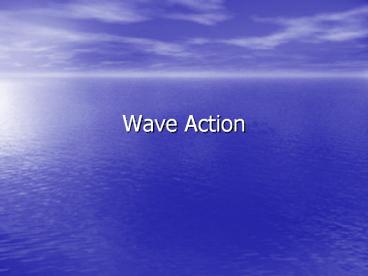Wave Action - PowerPoint PPT Presentation
Title:
Wave Action
Description:
Wave Action ... Wave Action – PowerPoint PPT presentation
Number of Views:112
Avg rating:3.0/5.0
Title: Wave Action
1
Wave Action
2
Wave Action
- Wave the movement of energy through a body of
water - Waves are formed when the wind blows across the
waters surface and transfers its energy to the
water.
3
Ocean Waves
4
Waves occur on the Lake Superior, too!
5
Wave Size
- Wave size depends on three things
- Strength of the wind
- Length of time that the wind blows
- Distance the wind travels
6
Wave Energy
- The energy of the wave can be moved from the
middle of the ocean to the shore, but the water
molecules will not end up at the shore. - The energy transfers, the water molecules remain
the same.
7
Water Molecule motion during a wave
- Water particles move in a circular pattern in the
upper portions of the water. - The deeper you get, the less the circular motion.
- Eventually you get deep enough that the circular
motion stops. - This is why sunken treasure never moves
8
Water motion
9
Wave Characteristics
- Crest top of the wave
- Trough bottom of the wave
- Wave Height from the bottom of the trough to
the top of the crest (just like your height) - Wave Length horizontal distance between crests
10
How do Waves Change near the Shore?
- Breakers white capped waves that crash onto the
shore - In deep water -gt waves travel as long,
- low waves called swells.
- In shallow water near the shore -gt wave
- height increases, wavelength decreases
- and breakers are created.
11
Tsunamis
- Tsunamis are waves caused by an earthquake
beneath the ocean floor - Most common in the Pacific Ocean.
- Alaska, Hawaii and the Pacific
- Northwest (Oregon and Washington)
- are the United States main concerns
- December 26, 2004 Indian Ocean
- tsunami that killed over 200,000 people
12
Tsunami
13
tsunami demo
14
How do waves affect the shore?
- Longshore Drift (Longshore current)
- Waves come into the shore at an angle, not
straight into the shore - When the wave goes back out, it pulls sediments
with it. - Waves go back in again, but the sediments are
moved slightly down the beach - Moves sediment slowly but constantly down the
beach.
15
Rip Currents
- Rip Currents are a rush of water that flows
rapidly back to sea through a narrow opening - They can be very dangerous, but narrow
- If you find yourself caught in one, you should
swim parallel to the shore to avoid the current,
then swim inland.
16
Escape a Rip Current
17
Waves Causing Beach Erosion
- Every minute of every day, the waves are
constantly eroding the beaches. They move
sediments from one place to the other. It becomes
even worse when a storm is present. - Local beaches have to compensate for the removal
of sand by off shore dredging. - How do the beach communities pay for this
replacement process?
18
Examples of Beach Erosion
19
Erosion after Hurricanes
20
Questions Section 13-1
- How do waves form?
- Why does an ocean buoy bob up and down in the
ocean? - How do wavelength and wave height change as a
wave enters shallow water? - Using what you know about wave height and wave
length of tsunamis, propose and explanation of
why tsunamis can cause so much damage when they
reach the shore.































